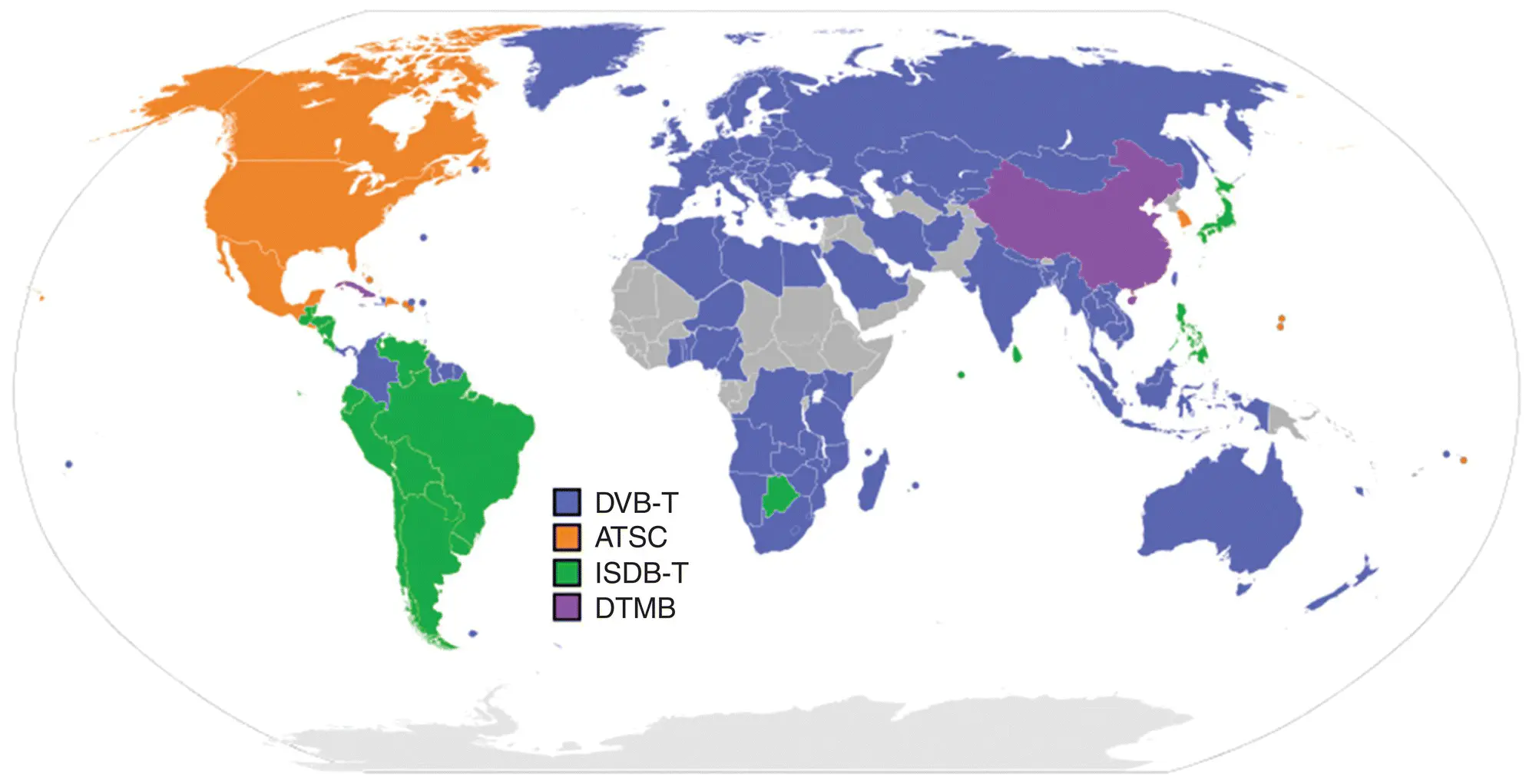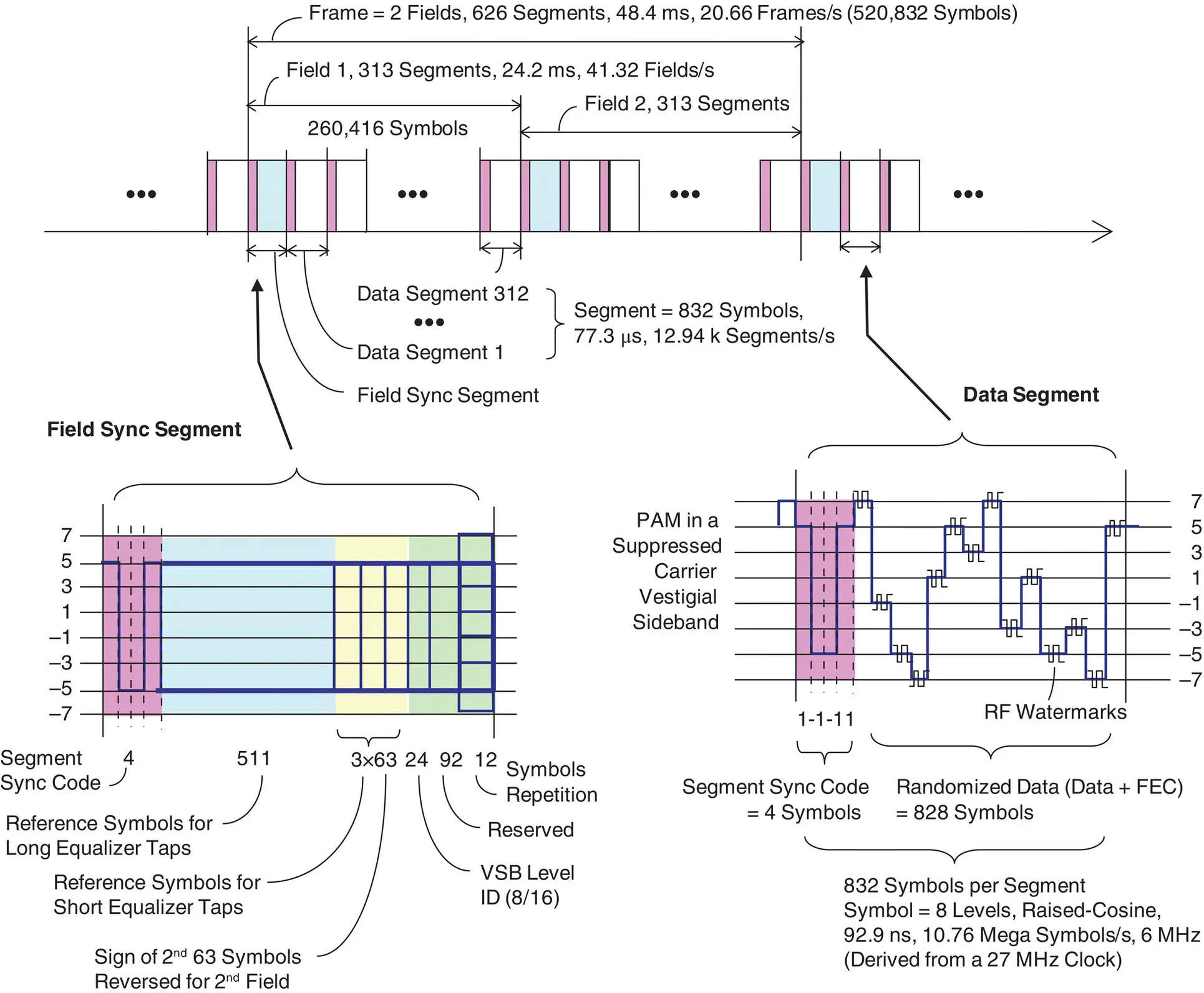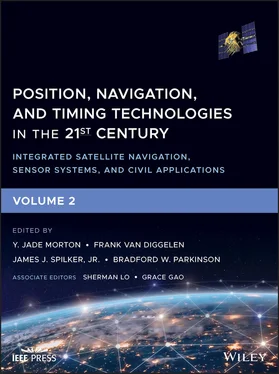Source Locations. As stated above, a critical aspect of positioning with SOOP is how to obtain accurate and up‐to‐date knowledge of the locations of signal sources or a database of location‐dependent signatures. Typically, the source locations such as DTV transmitters can be found from a regulatory registry or by a means of intelligence. A location‐dependent signature database, however, is only available for those regions that have been surveyed beforehand. Although the general characteristics of a SOOP can be learned from the standards to which the signal design adheres or estimated with SIGINT, there are circumstances in which the locations of signal sources are difficult to obtain. Some sources may be easily moved around. It is costly to build and maintain such a database. An alternative is to apply simultaneous localization and mapping of emitting radio sources (SLAMERS) [15, 16].
Clock Errors. The clocks of SOOP transmitters are initially unknown to a user, each subject to a different bias and drift. Although there are synchronous transmitters such as the single‐frequency network (SFN) for DVB, most of SOOPs are not synchronized. For synchronous transmitters, there is only one clock error between the network and the user, which can be estimated as part of the navigation solution. However, for asynchronous transmitters, there is a clock error term for each transmitter. To solve for such clock unknowns, self‐calibration can be applied when external information is available [17]. A reference station at a known location can estimate the transmitter clock errors and pass it along to the users [18, 19]. In the same way, two collaborative users can form a single spatial difference between their timing measurements with respect to a signal source, thus eliminating the common clock error [20, 21]. Both schemes, however, require a data link and synchronization between them. Another way to remove the clock error relative to a source is to form a temporal difference, leading to differential or relative range measurements for radio dead reckoning [22–25], which can be further combined with other sensors [26–27].
Number of SOOP and poor geometric dilution of precision (GDOP). The number of “independent” SOOP sources of the same kind in a region is typically not enough for robust and precise position location. Several antennas may be mounted on the same transmission tower. This tends to produce a rather poor GDOP. The problem may be alleviated by using different types of (mixed) SOOP such as TV and cellular signals [29, 30]. Making known displacements, a way to rotate the LOS vectors, is equivalent to adding fictitious sources at different locations to improve GDOP [21, 22]. Taking orthogonal measurements (e.g. obtain AOA in addition to TOA) is another way to enable positioning with limited signal sources.
2D versus 3D. Due to the limited height of terrestrial transmitters, the position solution is most likely to be two‐dimensional (2D) rather than three‐dimensional (3D). Compensation for slant ranges is required if significant height differences among transmitters and/or users are expected. Such compensation is facilitated when a digital terrain elevation database (DTED) is available. The height can also be solved with a radar or barometric altimeter.
Multipath at Reception. At reception, severe multipath is expected, particularly in an urban environment [31]. Multipath may create deep fading. Frequency diversity coding (OFDM) and spatial diversity combining (multiple‐input multiple‐output or MIMO) are techniques for better channel equalization. Rapid fading due to motion requires agile and robust tracking of code and carrier. While non‐line‐of‐sight (NLOS) signals are desirable for communications to reach shadowed areas, it is problematic for ranging. NLOS signals can be excluded, de‐weighted, or estimated as bias with robust estimation techniques. On the other hand, multipath can be exploited for constructive use [32, 33]. It can improve the positioning geometry when NLOS paths can be resolved from an environment map. In fact, multipath is troublesome only for geometric positioning methods, but it is rather a blessing for feature‐matching based (non‐geometric) methods, where multipath makes each location rather unique in terms of a rich set of features.
Signal Integrity/Authenticity. By its very nature, the use of SOOP faces the issues of integrity and authenticity in the context of navigation warfare. The signal physical characteristics and the information content carried on the signals can be used for authentication and assurance. Mixed SOOP and other types of sensors may be used for cross‐checking to ensure source authenticity, measurement integrity, and solution viability.
40.2 Representative Terrestrial Digital Broadcasting Signals
For terrestrial broadcasting of digital TV programs, there are four major systems, and their worldwide geographic distribution is shown in Figure 40.1[6, 35, 36]. In Europe, Australia, South Africa, India, and Southeast Asia, the standard is the DVB‐T (Digital Video Broadcasting – Terrestrial). An extension of DVB‐T, known as DVB‐T2, transmits compressed digital audio, video, and other data in “physical layer pipes” with a higher bit rate.
In the United States and South Korea, the standard is the American Television Standard Committee 8‐ary vestigial sideband modulation (ATSC‐8VSB), also known as ATSC 1.0. A next‐generation standard that leapfrogs to ATSC 3.0 will make use of advanced transmission and video/audio coding techniques to bring new and creative services to viewers. It is expected to hit the first 40 US television markets by the end of 2020.
In Japan and several South American countries, the DTV system is the ISDB‐T (Integrated Services Digital Broadcasting – Terrestrial). In China, including Hong Kong and Macao, and Cuba, the DTV standard is the DTMB (Digital Terrestrial Multimedia Broadcast). The DTMB contains both options for single‐carrier transmission (ATSC‐8VSB) and multi‐carrier transmission (TDS‐OFDM).
Corresponding to these terrestrial (T) versions, there are also versions for satellite transmission (S) and/or mobile and handheld (M/H) devices for the four standards, namely, DVB‐H/SH, ISDB‐S, and ATSC‐M/H. From the point of view of extracting TOA measurements without getting into the details of source and channel coding, bit error detection and correction, and data modulation and demodulation, we will review ATSC‐8VSB DTV signals in Section 40.2.1and DVB‐T signals in Section 40.2.2, respectively, together with software receivers for acquisition and tracking. ISDB‐T, DTMB, and ATSC 3.0 are briefly presented in Sections 40.2.3, 40.2.4, and 40.2.5, respectively.
40.2.1 Acquisition and Tracking of ATSC‐8VSB Signals for Timing and Ranging
As specified in [37], the ATSC‐8VSB DTV signal stream repeats a frame structure as illustrated in Figure 40.2. Each frame consists of two fields, marked as “Field 1” and “Field 2,” respectively; each field has 313 segments, and each segment has 832 symbols. In all, there are 520,832 symbols per frame and 260,416 symbols per field. The baseband signal has a symbol rate of 10.76 mega symbols per second (Msps). At such a rate, a segment lasts 77.32 μs, a field 24.2 ms, and a frame 48.4 ms.

Figure 40.1 Distribution of digital broadcasting systems for terrestrial television (Wikipedia [34]).
Source: Reproduced with permission of DVB.

Figure 40.2 Frame structure of ATSC‐8VSB DTV signals.
Читать дальше













